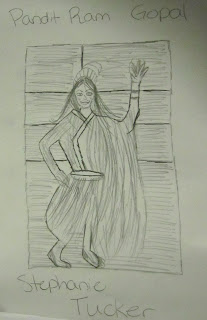When I read this question before seeing the collection, I assumed that I would not like the labels directly on the painting. I thought they would detract from the artwork and that it was unnecessary to spoil the art with a label. But once I saw them in the gallery, I actually liked them. I did not think they ruined the artwork at all and actually thought they enhanced the viewing experience. They all tried to match the gold of the artwork's frame and blended in quite nicely. For me, the labels on the frame made it feel more like I was viewing these collections in someone's lavish home instead of in a sterile museum environment. I also thought they fit the collection because they increased the grandeur of the piece and of the museum by not having awkward, stark white labels next to each painting.
My favorite piece from the collection was Gaspard Dughet's "The Falls of Tivoli." I liked this painting because of it's serenity. If I could imagine a place to escape whenever I wanted to relax and be alone to think, I would want to transport myself into the painting. I think the sound of rushing water is one of the most calming sounds in the world. I am also intrigued by the two people in the foreground. I want to know why they are down below the waterfall when all of the other townspeople are standing along the beach in the background.
For the object that intrigues or disgusts me based on lavish detailing, I was originally going to do a picture of a feast that included three lobsters, but then I saw this clock. It's not that I don't think this clock is gorgeous; it is definitely exquisite. But I don't think I would ever want something like this in my home. It's so unnecessary! There is just so much gold and so much going on. If I had this clock, I would constantly look at it to find out what time it was and never actually register the time because I would be so mesmerized by all of the detail.
My favorite museum we've visited is the Science Museum. It had so many different exhibits and was an enormous museum. I've actually never seen a science museum quite like it. Most science museums have exhibits about physics or electricity, but not about future environmental concerns or interesting current inventions. The Science Museum in London had an entire exhibit on plastic, detailing its history and showing current inventions using plastic. It also had a recyclable fashion exhibit, featuring fashion designers that use recyclable materials and their clothing. I liked the Science Museum best because I had a lot of fun there. I thought it was a really unique museum with tons of interesting exhibits.
I think I do have a greater interest in visiting museums after this course. After seeing so many, I want to visit more and compare them to one another. I was not previously intimidated by art, but I didn't find it as interesting as I do now. Before this course, I would have never visited an art museum on my own for fun. But now I would definitely seek out art museums and visit them. I also enjoyed the part of the course about branding. Whenever I visit museums of any type now, I always look at their logo and brochures and wonder if their font and designs fit with their museum's mission. I would have never thought about logos and themes of museums before this course.
































